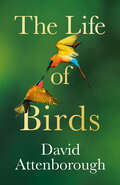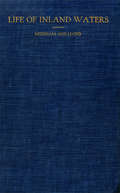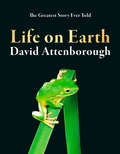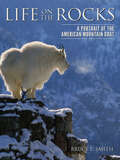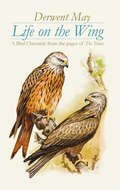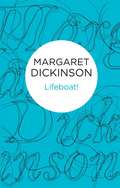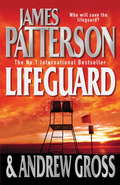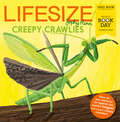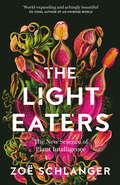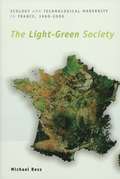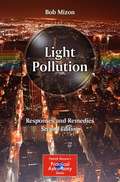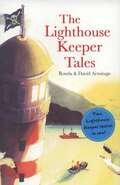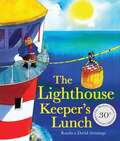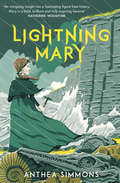- Table View
- List View
The Life of Birds
by David AttenboroughA fully updated new edition of David Attenborough’s bestselling classic.
Life of Inland Waters: An Elementary Text Book of Fresh-Water Biology For Students
by James G. NeedhamThis work is a textbook of fresh-water life dealing with its forms, its conditions, its fitnesses, its associations, and its economic aspects. The ecologic side of fresh-water biology is emphasized. Due consideration is given to the educational, economic, sanitary, social, civic, and aesthetic aspects of the subject.Limnology in America today is in its infancy. The value of its past achievements is just beginning to be appreciated. The benefits to come from a more intensive study of water life arc just beginning to be disclosed. That there is a widespread interest is already manifest in the large number of biological stations at which limnological work is being done.We recommend this volume as a general introduction to all students and teachers of this subject.
The Life of Mark Akenside: The Breakthrough to Modernity
by Barbara C. MordenMark Akenside (1721–1770) was a medical doctor and literary man whose influence on the history of ideas was profound.Born the son of a butcher in Newcastle Upon Tyne in 1721 Mark Akenside was awarded a degree in medicine from Edinburgh and Leyden Universities. He settled in London in 1743 where he was successful both as a doctor and in medical research. Above all, he was the author of The Pleasures of Imagination1744, an epic length poem in blank verse which broke many conventions of the time, exploring ideas about human perception and the natural world.Akenside had a European reputation and became a national celebrity. He was a major influence on first- and second-generation Romantic poets such as Wordsworth, Keats, Coleridge, etc. He also made an impact on the development of landscape painting in the early 19th century through his influence on J.M.W. Turner.This book examines these issues, as well as the controversy and speculation about Akenside’s relationship with his origins, his sexuality, and changing political affiliations in a period of economic crisis and great social change.
Life on Earth: The Web Of Life On Earth (Writers' Voices Ser.writers' Voices)
by David AttenboroughA new, beautifully illustrated edition of David Attenborough’s groundbreaking Life on Earth.
Life on the Rocks: A Portrait of the American Mountain Goat
by Bruce L. SmithThe American mountain goat is one of the most elusive and least familiar species of hoofed mammals in North America. Confined to the remote and rugged mountains of the western United States and Canada, these extraordinary mountaineers are seldom seen or encountered, even by those who patiently study them. Life on the Rocks offers an intimate portrayal of this remarkable animal through the eyes and lens of field biologist and photographer Bruce Smith. Color photographs and accounts of Smith's personal experiences living in Montana's Selway-Bitterroot Wilderness Area accompany descriptions of the American mountain goat's natural history. Smith explores their treacherous habitat, which spans the perilous cliffs and crags of the Rocky, Cascade, and Coast mountain ranges. The physical and behavioral adaptations of these alpine athletes enable them to survive a host of dangers, including six-month-long winters, scarce food sources, thunderous avalanches, social strife, and predators like wolves, bears, lions, wolverines, and eagles. Smith also details the challenges these animals face as their territory is threatened by expanding motorized access, industrial activities, and a warming climate. Life on the Rocks showcases the elegance and charm of this little-known creature, thriving in some of North America's harshest wilderness. Smith's volume will appeal to wildlife enthusiasts, wildland travelers, and conservationists interested in the future of the American mountain goat. 2014 National Outdoor Book Award winner: Nature & Environment and co-winner: Design and Artistic Merit
Life on the Wing: A Bird Chronicle from the pages of The Times
by Derwent MayFrom dainty avocets prancing along the seashore to panic-stricken waxwings frenziedly gobbling berries, from barking barnacle geese to soaring skylarks, Derwent May writes about birds in a very special way. As he goes in search of birdlife in a variety of places - the English lanes and rolling corn fields that he loves, the lonely Essex marshes, the remote bird-haunted islands of Grassholm and Fair Isle - May reveals just what it feels like to be a birdwatcher. With him, the reader will experience the excitement of fresh discoveries, the peace and contentment that birds can bring and the comedy to be found both in the behaviour of birds and the human response to them. May is an alert observer of avian habits and manners, describing them vividly and poetically, but underlying everything he writes is scientific knowledge and a wealth of experience. Employing all of these skills and drawing on his popular weekly 'Feather Reports' column from The Times, May creates a fascinating chronicle of a year in the life of our birds, from robins to rarities, with Peter Brown's illustrations adding the perfect finishing touch.
Lifeboat!
by Margaret DickinsonLifeboat! is the tense and dramatic story of the dangers faced by a rescue crew from Margaret Dickinson.In a holiday resort on the Lincolnshire coast at a Bank Holiday weekend the last thing Iain Macready, coxswain of the lifeboat, wants is a spate of hoax calls. But he and his crew have to deal with these just as they have to answer the genuine calls that inevitably come at holiday time. When a storm breaks over Saltershaven, Macready's own daughter is missing at sea in a sailing dinghy, whilst duty obliges Macready to set course away from the area where she may be to answer a distress call from a coaster.
Lifeguard: A Novel
by James Patterson Andrew GrossThe perfect job. Working for an easy-going boss at his luxurious mansion by the sun-kissed beach, watching beautiful women walk by. The perfect girl. Tess - gorgeous, funny, apparently very rich and crazy for him.The perfect score. Five million up for grabs. And to get his share, all he needs to do is trigger three house alarms to throw the cops off the scent of the real robbery.Could things get any better for Ned Kelly? But things don't go according to plan. And when Tess is brutally murdered and the others involved in the robbery are massacred, Ned is the prime suspect. With danger at every twist and turn, he's running for his life.
Life's Engines: How Microbes Made Earth Habitable
by Paul G. FalkowskiFor almost four billion years, microbes had the primordial oceans all to themselves. The stewards of Earth, these organisms transformed the chemistry of our planet to make it habitable for plants, animals, and us. Life's Engines takes readers deep into the microscopic world to explore how these marvelous creatures made life on Earth possible—and how human life today would cease to exist without them.Paul Falkowski looks "under the hood" of microbes to find the engines of life, the actual working parts that do the biochemical heavy lifting for every living organism on Earth. With insight and humor, he explains how these miniature engines are built—and how they have been appropriated by and assembled like Lego sets within every creature that walks, swims, or flies. Falkowski shows how evolution works to maintain this core machinery of life, and how we and other animals are veritable conglomerations of microbes.A vibrantly entertaining book about the microbes that support our very existence, Life's Engines will inspire wonder about these elegantly complex nanomachines that have driven life since its origin. It also issues a timely warning about the dangers of tinkering with that machinery to make it more "efficient" at meeting the ever-growing demands of humans in the coming century.
Life's Engines: How Microbes Made Earth Habitable
by Paul G. FalkowskiFor almost four billion years, microbes had the primordial oceans all to themselves. The stewards of Earth, these organisms transformed the chemistry of our planet to make it habitable for plants, animals, and us. Life's Engines takes readers deep into the microscopic world to explore how these marvelous creatures made life on Earth possible—and how human life today would cease to exist without them.Paul Falkowski looks "under the hood" of microbes to find the engines of life, the actual working parts that do the biochemical heavy lifting for every living organism on Earth. With insight and humor, he explains how these miniature engines are built—and how they have been appropriated by and assembled like Lego sets within every creature that walks, swims, or flies. Falkowski shows how evolution works to maintain this core machinery of life, and how we and other animals are veritable conglomerations of microbes.A vibrantly entertaining book about the microbes that support our very existence, Life's Engines will inspire wonder about these elegantly complex nanomachines that have driven life since its origin. It also issues a timely warning about the dangers of tinkering with that machinery to make it more "efficient" at meeting the ever-growing demands of humans in the coming century.
Life's Engines: How Microbes Made Earth Habitable (Princeton Science Library #137)
by Paul G. FalkowskiThe marvelous microbes that made life on Earth possible and support our very existenceFor almost four billion years, microbes had the primordial oceans all to themselves. The stewards of Earth, these organisms transformed the chemistry of our planet to make it habitable for plants, animals, and us. Life's Engines takes readers deep into the microscopic world to explore how these marvelous creatures made life on Earth possible—and how human life today would cease to exist without them.Paul Falkowski looks "under the hood" of microbes to find the engines of life, the actual working parts that do the biochemical heavy lifting for every living organism on Earth. With insight and humor, he explains how these miniature engines are built—and how they have been appropriated by and assembled like Lego sets within every creature that walks, swims, or flies. Falkowski shows how evolution works to maintain this core machinery of life, and how we and other animals are veritable conglomerations of microbes.A vibrantly entertaining book about the microbes that support our very existence, Life's Engines will inspire wonder about these elegantly complex nanomachines that have driven life since its origin. It also issues a timely warning about the dangers of tinkering with that machinery to make it more "efficient" at meeting the ever-growing demands of humans in the coming century.
Life's Engines: How Microbes Made Earth Habitable (Princeton Science Library #137)
by Paul G. FalkowskiThe marvelous microbes that made life on Earth possible and support our very existenceFor almost four billion years, microbes had the primordial oceans all to themselves. The stewards of Earth, these organisms transformed the chemistry of our planet to make it habitable for plants, animals, and us. Life's Engines takes readers deep into the microscopic world to explore how these marvelous creatures made life on Earth possible—and how human life today would cease to exist without them.Paul Falkowski looks "under the hood" of microbes to find the engines of life, the actual working parts that do the biochemical heavy lifting for every living organism on Earth. With insight and humor, he explains how these miniature engines are built—and how they have been appropriated by and assembled like Lego sets within every creature that walks, swims, or flies. Falkowski shows how evolution works to maintain this core machinery of life, and how we and other animals are veritable conglomerations of microbes.A vibrantly entertaining book about the microbes that support our very existence, Life's Engines will inspire wonder about these elegantly complex nanomachines that have driven life since its origin. It also issues a timely warning about the dangers of tinkering with that machinery to make it more "efficient" at meeting the ever-growing demands of humans in the coming century.
Lifesize Creepy Crawlies
by Sophy HennA fascinating glimpse into the magical world of minibeasts, from the star creator of the LIFESIZE series – exclusive for World Book Day!
Lifestyle and Nature: Integrating Nature Technology to Sustainable Lifestyles
by Ryuzo FurukawaEnvironmental constraints are becoming increasingly severe, and now more than ever it is time that we confront head-on the change from an "underground resources" type of civilization to one with a new way of life and technology that embraces a sense of nature. To do so, we need to understand the process of the civilization change. We must change our way of thinking to backcasting in order to design future lifestyles and learn from the elderly who lived with nature under severe environmental constraints more than 70 years ago. We must also learn from nature directly, the only sustainable society on earth. This book introduces Bio-TRIZ and ontology engineering to match and find technologies needed for spiritually affluent lifestyles. It provides many examples of Japanese cities that conducted lifestyle design projects based on nature technology. The book is a great reference for graduate-level students of environmental studies and engineering and for researchers in innovation, social science, engineering, and public policy, especially those with an interest in lifestyle change for a sustainable society.
Lifestyle and Nature: Integrating Nature Technology to Sustainable Lifestyles
by Ryuzo Furukawa Yuko Suto Emile H. Ishida Takeshi YamauchiEnvironmental constraints are becoming increasingly severe, and now more than ever it is time that we confront head-on the change from an "underground resources" type of civilization to one with a new way of life and technology that embraces a sense of nature. To do so, we need to understand the process of the civilization change. We must change our way of thinking to backcasting in order to design future lifestyles and learn from the elderly who lived with nature under severe environmental constraints more than 70 years ago. We must also learn from nature directly, the only sustainable society on earth. This book introduces Bio-TRIZ and ontology engineering to match and find technologies needed for spiritually affluent lifestyles. It provides many examples of Japanese cities that conducted lifestyle design projects based on nature technology. The book is a great reference for graduate-level students of environmental studies and engineering and for researchers in innovation, social science, engineering, and public policy, especially those with an interest in lifestyle change for a sustainable society.
Lifestyle Sports and Public Policy (Routledge Research in Sport, Culture and Society)
by Daniel Turner Sandro CarnicelliLifestyle Sports and Public Policy is the first book to develop a comprehensive understanding of the interplay between lifestyle sports and the public policy environment which frames and regulates them. Drawing on a wide range of lifestyle sports from across the globe, including parkour, skateboarding, mountain biking and climbing, it identifies the critical issues facing practitioners and policymakers as these sports become increasingly popular. Part I examines public sector bodies that provide lifestyle sports opportunities to the public, either through funding partners or by managing facilities themselves. Part II looks at the use of lifestyle sports to promote policy agendas such as improving public health, while Part III considers the impact of public sector regulatory actions on the lifestyle sports industry. Each part contains case studies which investigate a policy issue from the perspective of a different lifestyle sport, including some sports which have traditionally been under-represented such as rodeo and curling. This book is a valuable resource for anyone with an interest in lifestyle sports, leisure studies, sport tourism, leisure management or sport policy.
Lifestyle Sports and Public Policy (Routledge Research in Sport, Culture and Society)
by Daniel Turner Sandro CarnicelliLifestyle Sports and Public Policy is the first book to develop a comprehensive understanding of the interplay between lifestyle sports and the public policy environment which frames and regulates them. Drawing on a wide range of lifestyle sports from across the globe, including parkour, skateboarding, mountain biking and climbing, it identifies the critical issues facing practitioners and policymakers as these sports become increasingly popular. Part I examines public sector bodies that provide lifestyle sports opportunities to the public, either through funding partners or by managing facilities themselves. Part II looks at the use of lifestyle sports to promote policy agendas such as improving public health, while Part III considers the impact of public sector regulatory actions on the lifestyle sports industry. Each part contains case studies which investigate a policy issue from the perspective of a different lifestyle sport, including some sports which have traditionally been under-represented such as rodeo and curling. This book is a valuable resource for anyone with an interest in lifestyle sports, leisure studies, sport tourism, leisure management or sport policy.
A Lifetime of Seasons: The Best of Christopher Lloyd
by Christopher Lloyd'He was the best informed, liveliest and most innovative gardening writer of our times' GUARDIAN'Infuriating, irascible ... a brilliant gardener and a brilliant writer' Monty Don, ObserverChristo Lloyd was recognised as one of the foremost gardeners and garden writers of the 20th century. Here, for the first time, is the definitive collection of his best, most informative, and so often amusing, garden writing.Christo on gardening: Ours, in its humble way, is an art as well as a craft. At the same time it keeps us in touch with the earth, the seasons, and with that complex of interrelated forces both animate and inanimate which we call nature. It is a humanizing occupation.On weeding: Many gardeners will agree that hand-weeding is not the terrible drudgery that it is often made out to be. Some people find in it a kind of soothing monotony. It leaves their minds free to develop the plot for their next novel or to perfect the brilliant repartee with which they should have encountered a relative's latest example of unreasonableness.
The Light Eaters
by null Zoë SchlangerA narrative investigation into the new science of plant intelligence and sentience, from National Association of Science Writers Award winner and Livingston Award finalist Zoe Schlanger'. Look at the green organism across the room or through the window: the potted plant, or the grass, or a tree. Think how a life spent constantly growing yet rooted in a single spot comes with tremendous challenges. To meet them, plants have come up with some of the most creative methods for surviving of any living thing, us included. Many are so ingenious that they seem nearly impossible.There is no doubt that plants are important: plants, or their green precursors the blue-green algae and algae themselves, have produced all the oxygen in the Earth’s atmosphere, allowing animals to evolve.But did you know they can communicate when they are being eaten, allowing nearby plants to bolster their defences. They move and that movement stops when they are anaesthetised, just like animals. They also use electricity for internal communication, just like animals. They can hear the sounds of caterpillars eating, just like animals. Plants can remember the last time they have been visited by a bee and how many times they have been visited, so have a concept of time and can count, just like animals. Plants can not only communicate with each other, they can also communicate with other species of plant and animals, allowing them to manipulate animals to defend or fertilise them. This is unlike most other animals.So look again at the potted plant, or the grass or the tree and wonder: Are plants intelligent? Perhaps even more fundamental is are they conscious?Is the only real difference between animals and plants that plants are light eaters, animals aren’t.The Light Eaters will completely redefine how you think of plants. Packed with the most amazing stories of the life of plants it will open your eyes to the extraordinary green life forms we share the planet with. Of course, like animals, plants can also detect light.
The Light-Green Society: Ecology and Technological Modernity in France, 1960-2000
by Michael BessThe accelerating interpenetration of nature and culture is the hallmark of the new "light-green" social order that has emerged in postwar France, argues Michael Bess in this penetrating new history. On one hand, a preoccupation with natural qualities and equilibrium has increasingly infused France's economic and cultural life. On the other, human activities have laid an ever more potent and pervasive touch on the environment, whether through the intrusion of agriculture, industry, and urban growth, or through the much subtler and more well-intentioned efforts of ecological management. The Light-Green Society limns sharply these trends over the last fifty years. The rise of environmentalism in the 1960s stemmed from a fervent desire to "save" wild nature-nature conceived as a qualitatively distinct domain, wholly separate from human designs and endeavors. And yet, Bess shows, after forty years of environmentalist agitation, much of it remarkably successful in achieving its aims, the old conception of nature as a "separate sphere" has become largely untenable. In the light-green society, where ecology and technological modernity continually flow together, a new hybrid vision of intermingled nature-culture has increasingly taken its place.
Light Pollution: Responses and Remedies (The Patrick Moore Practical Astronomy Series)
by Bob MizonThere have been many developments in the field of light pollution over the last few years, and this second edition of 'Light Pollution - Responses and Remedies' will introduce them in detail. Examples include the appearance of anti-light pollution legislation in various countries, new departures in lighting design, human health implications, and the growing realization among the general public that lighting is not always a good thing. In this title, author Bob Mizon discusses the various ways in which wasted artificial light has damaged the quality of modern life, and suggest solutions. This book is for anyone who has experienced glare, discomfort, or nuisance from poorly directed lights; has wondered why we waste so much money lighting the sky; or anyone who simply wants to see the stars instead of a baleful urban glow. "Light Pollution, 2nd Edition" offers practical and inexpensive solutions to the world-wide problem of wasted artificial light, and emphasizes that light pollution is not just an astronomers' problem, but affects everyone in various ways.
Light to Life: The miracle of photosynthesis and how it can save the planet
by Raffael Jovine"Read this book and you will learn how photosynthesis was discovered, how it works, and how we can produce more food to feed the world." - PAUL NURSE, Nobel Prize winner and author of What is Life?In Light to Life, biologist Raffael Jovine takes us on a journey of discovery into the intricate, beautiful and often surprising processes that convert energy from the sun into life and how all-important these are to our survival.Despite the unprecedented challenges the Earth faces from global warming, habitat loss, air pollution and population growth; Jovine shows us that there is hope to be found. Photosynthesis is the very source of life: it has the power not just to produce food, but to reshape continents, drive biogeochemical cycles, stabilise the climate and regulate weather.In this exciting, revelatory book, Jovine unveils a blueprint for the future: greening the desert, bringing the ocean on land, planting mangrove forests and oyster banks, growing algae for animal feed, human food and soil carbon... He demonstrates how by harnessing photosynthesis we can regenerate the planet and revise the way we human beings interact with it.This book will help you to see the world in a different way, in all its wonderful detail - through the photosynthetic pigments in your eyes.
The Lighthouse Keeper Tales (The\lighthouse Keeper Ser.)
by Ronda Armitage David ArmitageWill Mr Grinling ever learn to surf? And will the Grinlings escape their pirate captors? Find out in these two charming Lighthouse Keeper tales, now in one fantastic B-format bind-up.
The Lighthouse Keeper's Lunch (The\lighthouse Keeper Ser.)
by Ronda Armitage David ArmitageAvailable for the first time as an ebook, THE LIGHTHOUSE KEEPER'S LUNCH is a modern classic, loved by children everywhere. Every day the lighthouse keeper tucks into a delicious lunch. But he isn't the only one who enjoys the tasty food. What will stop the greedy gulls from stealing the lighthouse keeper's lunch?
Lightning Mary
by Anthea SimmonsOrdinary is what most people are and I am not. I am not ordinary at all. I am a scientist.One stormy night, a group of villagers are struck by lightning. The only survivor is a baby - Mary Anning. From that moment on, a spark is lit within her.Growing up poor but proud on the windswept Dorset coast, Mary follows after her father, hunting for fossils uncovered by waves and landslips: ancient creatures, turned to stone. Ignoring other people's taunts, Mary faces danger to bring back valuable treasures to help feed her family. But tragedy and despair is never far away. Mary must depend upon her unique courage and knowledge to fulfil her dream of becoming a scientist in a time when girls have no opportunities for such ambitions. What will happen when she makes her greatest discovery of all...?With a factual section about Mary Anning, her life, and the discoveries she made.
